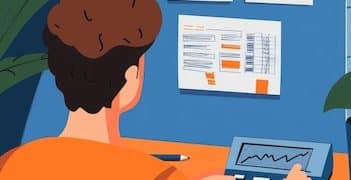Navigating Bankruptcy Options: Chapter 7 and 13 Debt Relief Guide

Navigating the complexities of bankruptcy options: a comprehensive guide to debt relief under Chapter 7 and Chapter 13 is crucial for individuals and businesses facing severe financial distress, offering structured legal pathways to discharge or reorganize debts and rebuild financial stability.
Facing overwhelming debt can be a daunting experience, leaving many individuals feeling lost and without hope. Fortunately, the U.S. legal system provides structured pathways for financial relief, primarily through bankruptcy options: a comprehensive guide to debt relief under Chapter 7 and Chapter 13. Understanding these distinct legal mechanisms is the first critical step toward regaining control of your finances and embarking on a fresh start. This guide aims to demystify the process, offering clarity on which option might be best suited to your unique circumstances.
Understanding the Core Principles of Bankruptcy
Bankruptcy, at its heart, is a federal legal process designed to help individuals and businesses eliminate or repay their debts under the protection of the bankruptcy court. It provides a legal reprieve from creditors, halting collection efforts and offering a chance to reorganize financial affairs. While often stigmatized, bankruptcy serves as a vital safety net, allowing people to discharge debts they can no longer afford to pay, or to create a manageable repayment plan through the court’s supervision. This process underscores a fundamental principle: giving debtors a fresh start when they’re genuinely overwhelmed.
The U.S. Bankruptcy Code outlines several types of bankruptcy, each tailored to different financial situations. For most individuals, the primary considerations revolve around Chapter 7 and Chapter 13. These chapters address different needs, from liquidating assets to repaying debts over time. Choosing between them involves a careful evaluation of income, assets, and the types of debts owed. The federal nature of bankruptcy law ensures a consistent framework across all states, though local court rules and practices can introduce nuances.
The Purpose of Bankruptcy Law
Bankruptcy law serves a dual purpose: it offers debtors a chance to escape overwhelming financial burdens, and it provides a structured process for creditors to receive some payment, if possible. This balance is crucial for maintaining economic stability. Without bankruptcy, individuals might remain trapped in cycles of debt indefinitely, hindering their ability to contribute productively to the economy. It’s not simply about debt eradication; it’s about economic rehabilitation.
- Provide a fresh start for debtors.
- Fairly distribute assets among creditors.
- Halt aggressive collection actions immediately.
The immediate effect of filing for bankruptcy is the “automatic stay,” which temporarily prevents most creditors from continuing collection activities. This includes lawsuits, foreclosures, repossessions, and garnishments. This vital protection offers debtors immediate relief, allowing them to assess their situation more calmly and prepare for the next steps in the bankruptcy process.
Navigating these initial stages requires careful attention to detail and a thorough understanding of legal requirements. Mistakes can lead to significant delays or even dismissal of the case. Therefore, seeking qualified legal counsel is almost always advised to ensure compliance and maximize the benefits of the bankruptcy filing.
Chapter 7 Bankruptcy: Liquidation and Fresh Start
Chapter 7 bankruptcy, often referred to as “liquidation bankruptcy,” is designed for individuals with limited income who cannot realistically pay off their debts. The primary goal is to discharge most unsecured debts, such as credit card balances, medical bills, and personal loans, allowing the debtor a fresh financial start. This process typically involves a bankruptcy trustee who reviews the debtor’s assets and finances, potentially liquidating non-exempt assets to repay creditors.
Eligibility for Chapter 7 is determined by a “means test,” which compares the debtor’s income to the median income in their state. If the income falls below the median, they generally qualify. If it’s above, further calculations are made to determine if they have enough disposable income to repay a significant portion of their debts. This test ensures that Chapter 7 is primarily available to those truly unable to afford a repayment plan.
The Means Test and Eligibility
The means test is a critical gateway to Chapter 7. It evaluates your average monthly income over the six months prior to filing and compares it to the median income for a household of your size in your state. If your income is below this median, you generally pass the test and are eligible for Chapter 7.
- Calculate average monthly income for the past six months.
- Compare income to state median for household size.
- If above the median, apply additional calculations for disposable income.
Even if your income is above the median, you might still qualify for Chapter 7 if your disposable income (income remaining after subtracting certain allowed expenses) is insufficient to make payments on a Chapter 13 plan. The means test aims to prevent abuses of the system by ensuring that debtors who can afford to repay creditors, even partially, pursue Chapter 13 instead.
Once deemed eligible, the debtor must compile a comprehensive list of all assets, debts, income, and expenses for their bankruptcy petition. This petition is a detailed financial snapshot that the court and trustee will review. Accuracy and completeness are paramount in this stage to avoid complications later on. The petition also identifies which assets are exempt from liquidation, typically protecting essential items like certain equity in a home or car, household goods, and retirement accounts.
A meeting of creditors, also known as the 341 meeting, is held approximately 30-45 days after filing. During this meeting, the trustee and any present creditors can ask questions under oath about the debtor’s financial situation. While creditors rarely attend for most individual cases, the trustee will verify the information in the petition and ensure compliance with bankruptcy law.

Chapter 13 Bankruptcy: Reorganization and Repayment
Chapter 13 bankruptcy, often called “reorganization bankruptcy” or “wage earner’s plan,” is designed for individuals who have a regular income and wish to repay some or all of their debts over a period of three to five years. Unlike Chapter 7, Chapter 13 doesn’t involve the liquidation of assets. Instead, debtors propose a repayment plan to the court, detailing how they will pay back their creditors from their disposable income.
This option is particularly beneficial for those who want to save their home from foreclosure, prevent vehicle repossession, or catch up on missed payments for secured debts. It also offers a way to pay off non-dischargeable debts through the plan, such as certain tax obligations or domestic support obligations. The plan must be approved by the bankruptcy court and must meet specific legal requirements, including paying all secured creditors and priority unsecured creditors in full.
Developing a Repayment Plan
The core of Chapter 13 is the repayment plan. This plan outlines how the debtor will use their disposable income to repay creditors over a set period. Disposable income is what’s left after reasonable and necessary living expenses are deducted from monthly income. The plan must be feasible, meaning the debtor must demonstrate the ability to make the proposed payments.
- Identify all debts and creditors.
- Calculate monthly disposable income.
- Propose a payment schedule over 3-5 years.
The repayment plan usually prioritizes certain debts. Secured debts, like mortgages or car loans, must typically be paid in full, often with interest. Priority unsecured debts, such as recent tax obligations or child support arrears, also receive special treatment. General unsecured debts, like credit card debts or medical bills, may receive only a partial payment or no payment at all, depending on the debtor’s income and the amount of debt.
A confirmable plan must also satisfy the “best interest of creditors” test, meaning unsecured creditors must receive at least as much as they would have under a Chapter 7 liquidation. Once the plan is confirmed by the court, the debtor makes regular payments to a Chapter 13 trustee, who then distributes the funds to creditors according to the approved plan. Upon successful completion of the plan, any remaining dischargeable unsecured debts are wiped out.
The Chapter 13 process offers significant advantages, such as curing mortgage defaults, stopping foreclosures, and protecting co-signers on debts. It provides a structured path to financial recovery without losing assets, as long as the debtor adheres to the payment schedule. However, failure to make payments can lead to the dismissal of the case or conversion to Chapter 7, highlighting the importance of a realistic and sustainable plan.
Key Differences Between Chapter 7 and Chapter 13
While both Chapter 7 and Chapter 13 aim to provide debt relief, they operate under fundamentally different frameworks, each suitable for distinct financial scenarios. Understanding these differences is crucial for making an informed decision about which path to pursue. The choice often hinges on factors such as income, asset ownership, the types of debts you hold, and your long-term financial goals.
Chapter 7 is a quicker process, typically lasting 4-6 months, and results in a complete discharge of most unsecured debts, but it may involve selling non-exempt assets. Chapter 13, on the other hand, is a longer commitment, spanning 3-5 years, where debtors repay debts through a court-approved plan. It’s ideal for those with a consistent income who want to protect assets or cure defaults on secured debts.
Eligibility and Income Thresholds
A primary differentiator lies in the eligibility criteria, particularly regarding income. Chapter 7 is generally for individuals with lower incomes who struggle to meet their basic living expenses and have little to no disposable income. The means test is the gatekeeper here. Chapter 13 is for debtors with a steady income that allows them to make regular payments toward a repayment plan. There are also debt limits for Chapter 13; certain individuals with very high debts may not qualify.
- Chapter 7: Primarily for low-income individuals; strict means test.
- Chapter 13: For individuals with regular income; debt limits apply.
- Means test for Chapter 7 checks disposable income.
Another significant difference is the treatment of assets. In Chapter 7, a trustee may sell non-exempt assets to pay creditors. While many everyday assets are exempt under federal or state law, this is a distinct possibility. In Chapter 13, debtors retain all their property, but they must repay creditors an amount equivalent to what those creditors would have received in a Chapter 7 liquidation.
The types of debts each chapter can address also vary. Chapter 7 typically discharges most unsecured debts, like credit card debts and medical bills. However, certain debts, such as student loans (unless proven undue hardship), recent taxes, and child support, are generally “non-dischargeable” in Chapter 7. Chapter 13 allows for the discharge of a broader range of debts upon successful completion of the repayment plan, and it can also save homes from foreclosure by allowing debtors to catch up on mortgage arrears through the plan.
The timeline and process duration are also critical. Chapter 7 is often concluded within six months, offering a relatively quick resolution. Chapter 13 involves a commitment of three to five years, during which the debtor must consistently make payments to the trustee. This longer duration means a sustained effort and financial discipline are required for Chapter 13. Each option caters to different financial realities and provides distinct paths toward debt relief, emphasizing the need for careful consideration.
The Bankruptcy Process: Step-by-Step Overview
Filing for bankruptcy, regardless of whether it’s Chapter 7 or Chapter 13, follows a structured legal process involving several key stages. While the specifics differ between chapters, the overall journey from initial consultation to discharge involves preparation, filing, meetings, and adherence to court requirements. Understanding these steps can help demystify the process and alleviate some of the associated stress.
The journey typically begins with a thorough evaluation of your financial situation, often in consultation with a qualified bankruptcy attorney. This initial assessment helps determine eligibility for each chapter and outlines the potential benefits and drawbacks. Following this, significant preparation is required to compile all necessary financial documentation, which forms the basis of your bankruptcy petition.
Pre-Filing Requirements and Credit Counseling
Before you can even file your bankruptcy petition, federal law requires you to complete a credit counseling course from an approved agency. This course aims to provide information on managing money, debts, and potential alternatives to bankruptcy. It typically lasts about an hour and can be completed online or over the phone. A certificate of completion must be filed with the court.
- Complete mandatory credit counseling course.
- Gather all financial documents (pay stubs, tax returns, debt statements).
- Consult with a bankruptcy attorney.
Once credit counseling is complete, you and your attorney will prepare the bankruptcy petition and schedules. These extensive documents detail all your assets, liabilities, income, expenses, and financial transactions from the recent past. Accuracy is paramount, as any inconsistencies or omissions can lead to legal issues, including the dismissal of your case or even charges of fraud. This phase is crucial for establishing the complete picture of your financial standing.
After filing, the “automatic stay” comes into effect, providing immediate protection against most collection actions. This means creditors cannot call you, sue you, garnish your wages, repossess your car, or foreclose on your home without court permission. This crucial relief offers a breathing room to address your financial challenges without constant harassment.
Approximately 30-45 days after filing, you must attend the Meeting of Creditors (341 meeting). This meeting is an opportunity for the trustee and any present creditors to ask questions under oath about your financial situation. While it can seem intimidating, it’s usually straightforward, especially if you have an attorney. In Chapter 7, the trustee may then liquidate non-exempt assets. In Chapter 13, the court will hold a confirmation hearing for your repayment plan. Finally, after successful completion of all requirements (including the repayment plan in Chapter 13 and a second financial management course), your debts are discharged, marking a significant milestone in your financial recovery.
Dischargeable vs. Non-Dischargeable Debts
One of the most critical aspects of exploring bankruptcy options is understanding which debts can be eliminated (“discharged”) and which ones will remain (“non-dischargeable”). This distinction heavily influences the effectiveness of bankruptcy as a debt relief tool and plays a significant role in deciding between Chapter 7 and Chapter 13. Not all debts are treated equally under bankruptcy law, and the specifics can vary based on the chapter filed.
Generally, Chapter 7 offers a broad discharge of unsecured debts, providing a clean slate for many individuals. Chapter 13, while involving a repayment plan, can sometimes provide a pathway to discharge certain debts that would be non-dischargeable in Chapter 7 upon successful completion of the plan. Knowing this difference is paramount for strategic financial planning post-bankruptcy.
Common Dischargeable Debts
The majority of unsecured debts are dischargeable in a Chapter 7 bankruptcy. These are debts not backed by collateral, meaning a creditor cannot repossess property if you fail to pay. Common examples include:
- Credit Card Debts: Balances on credit cards are typically discharged.
- Medical Bills: Outstanding hospital and doctor bills can be eliminated.
- Personal Loans: Unsecured loans from banks or individuals are usually dischargeable.
- Collection Agency Debts: Debts assigned to collections are generally included.
While most unsecured debts are dischargeable, there are some exceptions, known as priority debts, even within Chapter 7. These may include certain tax debts, domestic support obligations, and government-backed student loans. Understanding these nuances is crucial for setting realistic expectations about debt relief.

Chapter 13 provides an even broader discharge for certain debts through its repayment plan structure. For example, some debts that are non-dischargeable in Chapter 7, such as certain fines or non-support community property obligations from divorce, may be discharged upon successful completion of a Chapter 13 plan. This makes Chapter 13 an attractive option for individuals with complex debt profiles.
However, some debts are almost universally non-dischargeable in both Chapter 7 and Chapter 13. These include most student loans (though there’s a strict “undue hardship” test that is rarely met), court-ordered alimony and child support, recent income taxes, and debts incurred through fraud. Criminal fines and restitution orders are also generally not dischargeable. It is critical to consult with a bankruptcy attorney to fully understand how your specific debts will be treated under each chapter.
Impact on Credit and Future Financial Planning
Filing for bankruptcy, whether Chapter 7 or Chapter 13, undoubtedly has a significant impact on your credit score and financial future. While it provides immediate relief from debt overwhelming, it also leaves a mark on your credit report for several years. However, this impact is often temporary, and bankruptcy can serve as a necessary step towards rebuilding a stronger financial foundation, sometimes even leading to improved credit sooner than if you continued struggling with insurmountable debt.
The initial dip in your credit score following a bankruptcy filing is usually substantial. However, for many individuals already facing severe financial distress, their credit score may already be significantly damaged. Bankruptcy can effectively hit reset, allowing them to begin the rebuilding process without the constant burden of unpaid debts and collection calls.
Credit Report Implications and Rebuilding Strategies
A Chapter 7 bankruptcy typically remains on your credit report for 10 years from the filing date, while a Chapter 13 bankruptcy stays for 7 years. Despite this, it’s possible to start rebuilding your credit much sooner. Lenders often view bankruptcy as a sign that you’re no longer burdened by old debts, which can make you a more attractive borrower for new credit, albeit at higher interest rates initially.
- Bankruptcy remains on credit report for 7-10 years.
- Start rebuilding credit with secured credit cards or small loans.
- Monitor credit report regularly for errors.
One of the most effective strategies for rebuilding credit post-bankruptcy is to obtain a secured credit card. These cards require a cash deposit that serves as your credit limit, reducing risk for the lender. By making small, regular purchases and paying the balance in full each month, you can demonstrate responsible credit behavior. Another option is a small secured loan, often called a credit-builder loan, designed specifically to help individuals establish or re-establish credit. These loans involve saving money with a lender while making payments, ultimately reporting positive payment history to credit bureaus.
It’s also crucial to monitor your credit report carefully for any inaccuracies or old debts that were discharged but still appear as outstanding. Disputing these errors can help improve your score. Additionally, focusing on financial stability – building an emergency fund, living within your means, and avoiding new debt – is paramount. Bankruptcy provides an opportunity for a fresh start, but sustained financial health depends on adopting prudent money management habits. Over time, consistent positive financial behavior will significantly outweigh the initial impact of bankruptcy on your credit and open doors to new financial opportunities.
Seeking Professional Legal Advice
The decision to file for bankruptcy is significant and carries long-term financial implications. It’s not a step to be taken lightly or without careful consideration of all options. Navigating the complex legal framework of bankruptcy, understanding eligibility criteria, differentiating between dischargeable and non-dischargeable debts, and preparing accurate documentation requires specialized knowledge. This is where the expertise of a qualified bankruptcy attorney becomes invaluable.
While some individuals might consider filing for bankruptcy without legal representation, known as “pro se,” this path is fraught with potential pitfalls. The complexities of bankruptcy law, the strict deadlines, and the precise documentation requirements can be overwhelming for someone without legal training. Mistakes can lead to delays, dismissal of the case, loss of assets, or even the inability to discharge debts.
The Role of a Bankruptcy Attorney
A bankruptcy attorney serves as your advocate and guide throughout the entire process. They will evaluate your financial situation, determine your eligibility for Chapter 7 or Chapter 13, and advise you on the most suitable course of action. They prepare and file all necessary paperwork, ensuring accuracy and compliance with federal and local bankruptcy rules. They will also represent you at all required court hearings, including the Meeting of Creditors.
- Assess your financial situation and eligibility.
- Prepare and file all bankruptcy documents.
- Represent you at court hearings and creditor meetings.
- Offer guidance on post-bankruptcy financial recovery.
Beyond the procedural aspects, an attorney can provide critical advice on strategic decisions, such as which assets are exempt from liquidation, how to deal with secured creditors, and the implications for co-signers on debts. They can also help you understand the long-term impact on your credit and devise strategies for rebuilding your financial future. Their expertise can help maximize the benefits of bankruptcy while minimizing potential risks and ensuring a smoother process.
When choosing an attorney, look for someone specializing in bankruptcy law, with a strong track record and clear communication. A good attorney will explain the process in simple terms, answer all your questions, and be transparent about fees. While hiring an attorney involves costs, the investment often pays off by preventing costly errors, reducing stress, and ensuring a successful outcome. Considering the significant financial relief and fresh start that bankruptcy can offer, professional legal guidance is often a critical component for achieving long-term financial stability.
Alternatives to Bankruptcy
While bankruptcy offers a powerful solution for overwhelming debt, it is crucial to recognize that it is not the only path to financial recovery. For some individuals, alternatives to bankruptcy might be more appropriate, offering ways to manage debt without the long-term credit implications associated with a bankruptcy filing. Exploring these options before making a final decision can ensure you choose the best strategy for your unique situation.
These alternatives range from informal negotiations with creditors to more structured debt management programs. The suitability of each option depends on factors such as the amount of debt, the type of debt, your income level, and your willingness to commit to a repayment plan. A proper understanding of these choices provides a comprehensive perspective on debt relief.
Debt Management Plans and Consolidation
One common alternative is enrolling in a debt management plan (DMP) through a credit counseling agency. In a DMP, the agency negotiates with your creditors to reduce interest rates, waive late fees, and consolidate your unsecured debts into a single, affordable monthly payment. You make one payment to the agency, which then distributes funds to your creditors. These plans typically last 3-5 years and can significantly reduce your overall payment burden without formally impacting your credit score as severely as bankruptcy.
- Credit counseling agency negotiates with creditors.
- Reduced interest rates and waived fees.
- Single monthly payment to the agency.
Debt consolidation is another popular option, usually involving taking out a new loan to pay off multiple existing debts. This can simplify your payments and potentially secure a lower interest rate, reducing your overall cost of borrowing. However, it requires a good credit score to qualify for favorable terms, and it doesn’t reduce the principal amount of debt. Transferring high-interest credit card balances to a lower-interest personal loan or a balance transfer credit card are common forms of debt consolidation.
Negotiating directly with creditors can also be effective. If you’re experiencing temporary financial hardship, you might be able to arrange a temporary payment plan, a reduced interest rate, or even a partial debt forgiveness with your creditors. This process requires good communication and a clear understanding of your financial limits. For secured debts, refinancing or loan modifications can sometimes prevent foreclosure or repossession.
Finally, debt settlement involves negotiating with creditors to pay a lump sum that is less than the total amount owed. This can be effective for unsecured debts, but it often requires a substantial amount of money upfront, can negatively impact your credit, and may result in taxable phantom income. Each of these alternatives presents its own set of advantages and disadvantages, making a thorough analysis and often professional guidance essential.
| Key Point | Brief Description |
|---|---|
| ✅ Chapter 7 | Quick debt discharge (4-6 months) for low-income debtors, may involve asset liquidation. |
| 🔄 Chapter 13 | 3-5 year repayment plan for debtors with regular income, allows asset retention. |
| ⚖️ Eligibility | Determined by means test for Chapter 7; income/debt limits for Chapter 13. |
| 👨⚖️ Legal Advice | Highly recommended to navigate complex laws and ensure optimal outcomes. |
Frequently Asked Questions About Bankruptcy
Chapter 7 involves liquidating non-exempt assets to pay creditors and discharging most unsecured debts, generally for those with lower incomes. Chapter 13 is a reorganization bankruptcy for individuals with regular income who repay debts over 3-5 years while retaining their assets.
Not necessarily. Most Chapter 7 filers retain most, if not all, of their property due to bankruptcy exemptions under federal or state law. These exemptions protect essential assets like your home, car, and household goods up to a certain value. An attorney can help identify what is exempt.
A Chapter 7 bankruptcy remains on your credit report for 10 years from the filing date, while a Chapter 13 bankruptcy stays for 7 years. Despite this, you can start rebuilding your credit relatively quickly through responsible financial practices after the discharge.
Discharging student loans through bankruptcy is very difficult. You must prove “undue hardship” through a separate legal action, which requires demonstrating you cannot maintain a minimal standard of living, the hardship will persist, and you made good faith efforts to repay.
While it is possible to file “pro se,” it is highly recommended to hire a qualified bankruptcy attorney. The laws are complex, mistakes can be costly, and an attorney can navigate the process, protect your assets, and ensure the best possible outcome for your situation.
Conclusion
Navigating the complex landscape of bankruptcy options: a comprehensive guide to debt relief under Chapter 7 and Chapter 13 reveals two distinct but equally vital pathways for individuals facing insurmountable debt. While Chapter 7 offers a quick fresh start through liquidation for those with limited income, Chapter 13 provides a structured repayment plan for debtors with steady earnings who wish to protect their assets. The decision between these options is deeply personal and hinges on a thorough assessment of your financial situation, debt types, and long-term goals. Regardless of the path chosen, bankruptcy, when approached with diligent preparation and often professional legal guidance, serves as a crucial mechanism for financial rehabilitation, offering a chance to rebuild a stable and secure future free from the immediate burden of overwhelming debt. Understanding these processes empowers individuals to make informed decisions and take the decisive steps necessary to regain financial control.





